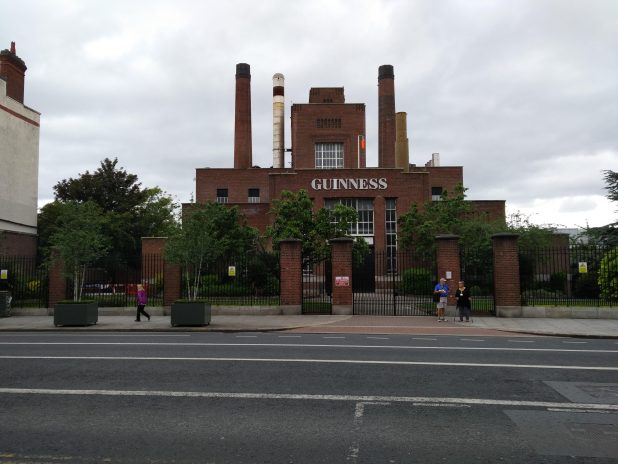If you’re ever in London and have an interest in modern art, the Tate Modern will be one of the first stops on your itinerary. The gallery is housed in the former Bankside power station, which was finally completed in 1963. It’s an imposing and overtly industrial structure that dominates the skyline. The power station was designed by Sir Giles Gilbert Scott, who was also responsible for the even more iconic Battersea power station, which featured on the cover of Pink Floyd’s Animals, released in 1977.
I’ve always been fascinated by these kind of buildings, their huge scale and the way they’re unapologetically at odds with their surroundings and I’m proud that we have our very own example of this type of construction here in James Street. The Guinness power house which was designed by FRM Woodhouse with credit also given to Sir Alexander Gibb and Partners.
The power house is a charming, yet symmetrically imperfect thing out of time. It was originally intended to be constructed in the 1930’s as part of a modernisation of the Guinness Brewery but was delayed due to the outbreak of the second world war. It was finally completed in 1948, two years after the death of Woodhouse and by which time, the architectural style of these types of constructions had moved on to another place.
Now, in 2017, the power station is about to be transformed into a whiskey distillery by Diageo Ireland under the brand name, Roe & Co. This follows a trend which has seen several distilleries open or planned nearby including, The Pearse Lyons Distillery, The Teeling Distillery, and the Dublin Liberties Distillery.
The Roe & Co. distillery will include a visitor’s centre which will focus on the life of distiller George Roe who ran a large distillery, also on James Street. Construction will begin in 2019, so the first batch of whiskey distilled on the site won’t be ready until 2022 possibly 2023. Diageo hopes that up to 50,000 people will pay a visit every year. The product itself is described as being, “made from finest hand-selected stocks of Irish malt and grain whiskies, aged in bourbon casks.”
Speaking back in January before planning permission was given, Colin O’Brien, the Operations Director of Diageo Ireland said: “The planned distillery will provide employment in the coming years – both at construction and operation stages. It will complement what is already the country’s most popular tourism offering, The Guinness Storehouse. This investment further demonstrates Diageo’s commitment to the growing vibrancy of The Liberties, one of the City’s most dynamic districts and the home of Irish Whiskey during the original golden age of Irish distilling. We are excited that the planned distillery will help revive the proud tradition of distilling in the Liberties.”
I spoke to Martin Duffy, co-producer at the Chicago Independent Spirt Expo and former Senior Master of Whikey for Diageo. He welcomed the news and feels that the Irish Whiskey market is ready for this kind of change – with a some caveats, “Irish whiskey is one of the fastest growing categories of whiskey in the world at the moment, so there is a market. There are a few catches to this, however, since it will take at least three years for any distillery to put out anything that can be called “whiskey”.
“By that time, will Irish whiskey still be on a roll. It is also doubtful that most distilleries will put out a whiskey that young, so it could be even longer before you see any juice coming from these newer distillers, and perhaps less chance that the category will still be hot. Another fact is that much of the rise in sales of Irish whiskey is due to large sales in Jameson, which makes up about 80-85% of the Irish whiskey market. Another reason, however, for the growing number of new distilleries in Ireland could be that over the past 10 years there more native Irishman have rediscovered an industry that they once dominated.”
Martin also remembers his time in Dublin and its small but burgeoning Whiskey scene. “There was a Irish Whiskey Appreciation Society, which was a small, but dedicated group of fans of Irish whiskey, both past & present. Since then, that group has grown. Dublin now hosts its own Whisky Live. Pubs see having a good selection of Irish whiskey on their back bar can boost tourist trade. Irish bartenders, connecting with fellow bartenders from the U.S. and around the world, have rediscovered whiskey cocktails.
“There is also an uptick in newer micro-breweries, which provides a perfect source of materials to distil whiskey (plus the beer, which can be produced quicker, provides needed revenue while your whiskey is maturing. Kind of a perfect storm, but hopefully everyone building a distillery now knows that producing an Irish whiskey is just half the battle. The other half will be promoting it and making a case why someone should drink your whiskey over one of the other new spirits in the pipeline.”
The final announcement for the distillery came after Dublin City Council gave the go-ahead. They felt that, “the development would provide a sustainable use for a currently disused part of the urban fabric, retaining part of the industrial heritage of the area. The granting of the application comes against the background of a resurgence in the Irish whiskey in recent years where exports have grown by over €215m over the past decade.”









